Blackjack 3 to 2: How to play
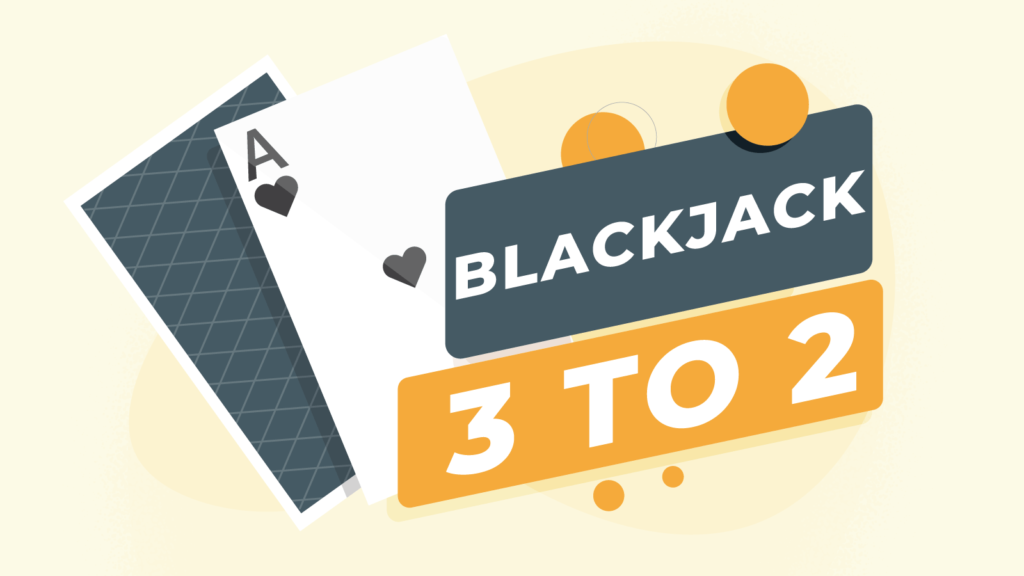
Ever wondered what is the most important rule on the Blackjack table? Experts explain the Blackjack 3 to 2 payout and its importance for the British gambler.
Blackjack pays 3 to 2
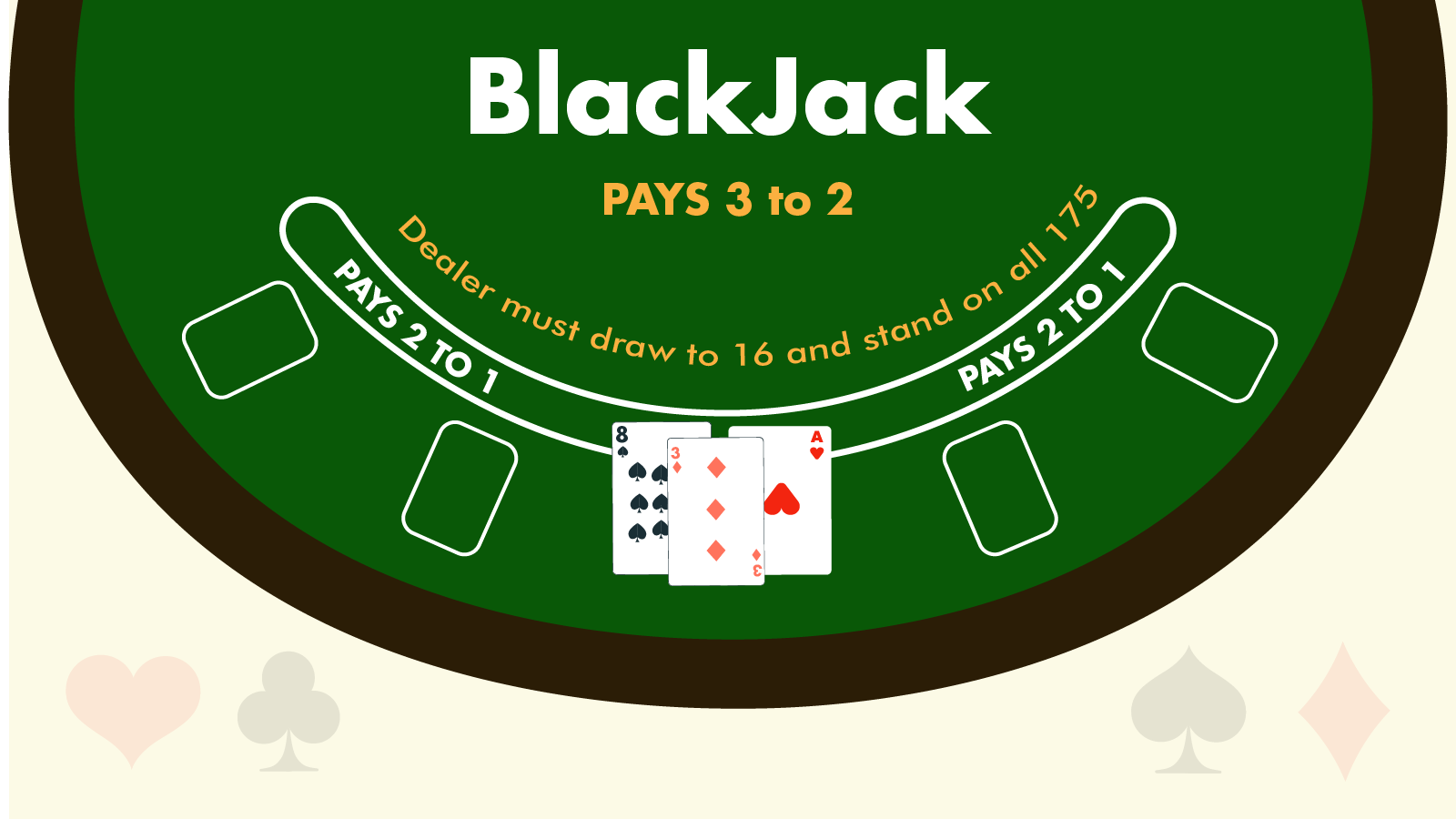
This crucial rule refers to the amount received when the Blackjack player has a hand amounting to 21.
You will find it written in large letters on most casino tables. The statement refers to one of the most basic rules of the table game.
Simply put, the pay rule means that you will receive £3 for every £2 wagered, or an equivalent percentage. This rule is slightly better than simply having a better hand than the dealer’s. This latter situation has a 1 to 1 rule. Thus, if you beat the bank with a hand that falls short of the 21 value, you get the equivalent of your wager.
The Blackjack Pays 3 to 2 In Action
- £1→£0.15
- £5→£0.75
- £1→£1.5
- £2→£3
- £3→£4.5
- £5→£7.5
- £10→£15
- £20→£30
- £50→£75
- £100→£150
- £200→£300
- £250→£375
- £1000→£1500
Blackjack Payout Chart
| The Bets | The Standard Pay |
|---|---|
| Blackjack | 3:2 |
| Insurance | 2:1 |
| Non-Blackjack Win | 1:1 |
These bets are essential for any version of the game. However, the insurance option will not always be available.
Beyond the basic betting schemes, British players can play at tables with several side bet types. The 21+3 and Perfect Pairs side bets in Blackjack are some of the most frequently encountered.
Perfect Pairs Table
| Pair Type | Pay Scheme |
|---|---|
| Unsuited | 5:1 / 8:1 |
| Unsuited & Same Colour | 10:1 |
| Suited | 25:1 / 30:1 |
21+3 Bets Table
| Bets | Pay Table |
|---|---|
| Flush | 5:1 |
| Straight | 10:1 |
| Three of a Kind | 30:1 |
| Straight Flush | 40:1 |
| Suited Three of a Kind | 100:1 |
Hot3 Table
| Dealer’s Hand Value | Pay Scheme |
|---|---|
| 19 | 1:1 |
| 20 | 4:1 |
| 21 | 20:1 |
| Three 7s | 100:1 |
Hot3 bets consider the sum value of your two initially dealt cards as well as the dealer’s upcard.
Bust It Table
| Cards on Bust | Pay Table |
|---|---|
| 3 Cards | 1:1 |
| 4 Cards | 2:1 |
| 5 Cards | 9:1 |
| 6 Cards | 50:1 |
| 7 Cards | 100:1 |
| 8 Cards | 250:1 |
Bust it wagers concern the number of additional cards held by the dealer when busting. Naturally, the odds of having five playing cards or more get rapidly slimmer, corresponding to a higher return.
British table game players will also find four rarer types of betting schemes:
- Royal Match
- Super Sevens
- Lucky Ladies
- Over/Under 13
These are the blackjack payout tables for each:
Royal Match Table
| Match Types | Pay Table |
|---|---|
| Royal Match | 5:2 |
| Suited Kind and Queen | 24:1 |
Super Sevens Table
| Number of Sevens | Pay Table |
|---|---|
| 1 Seven | 3:1 |
| 2 Unsuited Sevens | 50:1 |
| 2 Suited Seven | 100:1 |
| 3 Unsuited Sevens | 500:1 |
| 3 Suited Sevens | 5000:1 |
Lucky Ladies Table
| Pairs | Pay Scheme |
|---|---|
| Unsuited | 4:1 |
| Suited | 10:1 |
| Suited & Same Rank | 25:1 |
| 2 Queens of Hearts | 200:1 |
| 2 Queens of Hearts & Dealer 21 | 1000:1 |
Tips
Over/Under 13 is a side bet type that has you wager on whether the sum of your cards exceeds 13 or stays below it. If it is 13, you will generally lose the bet, but some casinos will allow betting on having exactly a 13 sum.
Why is the Blackjack 3:2 payout more important than other bet types?
You can see from the tables that the standard rule pay amount is lower than that for other side bets. Its importance comes from the fact that, as opposed to side bets which are optional, the 3:2 payout always is “on the table.” More so, most results that end up in a successful side bet have low odds of occurrence.
However, from the basic Blackjack odds theory, the probability of getting a natural blackjack is better.
Odds for a 3:2 Payment
- 1 Deck of Cards – 4.826%
- 2 Decks of Cards – 4.779%
- 4 Decks of Cards – 4.756%
- 5 Decks of Cards – 4.745%
- 6 Decks of Cards – 4.749%
- 8 Decks of Cards – 4.745%
How to Better Read Payouts

To better assess the Blackjack 3 to 2 meaning, you should understand how to quickly figure out how much real money a successful bet returns.
The 3:2 payout has a proportional formulation that may prove difficult to read for British players unaccustomed to Blackjack games slang. You have seen that for a £2 wager, you will receive £3, but there is a simpler way to see the return for any bet amount.
Tips
Standard rules pay amount is equivalent to 1.5:1. To determine how much you get back following a successful round, you should multiply your initial bet by 1.5.
Learning to read payouts properly will help you quickly tell apart a bad bet from a worthwhile one. You can reduce the general process to a few simple steps:
Steps to Figure Out Blackjack Payout Amounts
- Find out the Blackjack payout for the bet.
- Divide both numbers by the second one.
- Multiply your bet with the first result.
This process will show you the resulting return. You have seen how the pay scheme works for low wagers.
How much do you get for a £25 bet, based on the Blackjack pays 3:2 rule?
You start by dividing the numbers by 2. You get 1.5:1 instead of 3:2. Then you multiply your initial wager by the first number. Thus, you get £25 × 1.5 = £37.5.
This approach will work for any pay scheme that is given in the proportional formulation.
Examples of Different Payouts for a £25 Bet
- 1:1 pays out £25.
- 5:2 pays out £62.5. This value is equivalent to 5 divided by 2 and multiplied by £25.
- 9:1 pays out with £225, or nine times your wager.
- 6:5 pays out with £30 since 6:5 is the same as 1.2:1.
Blackjack Pays 3 to 2 Meaning for House Edge
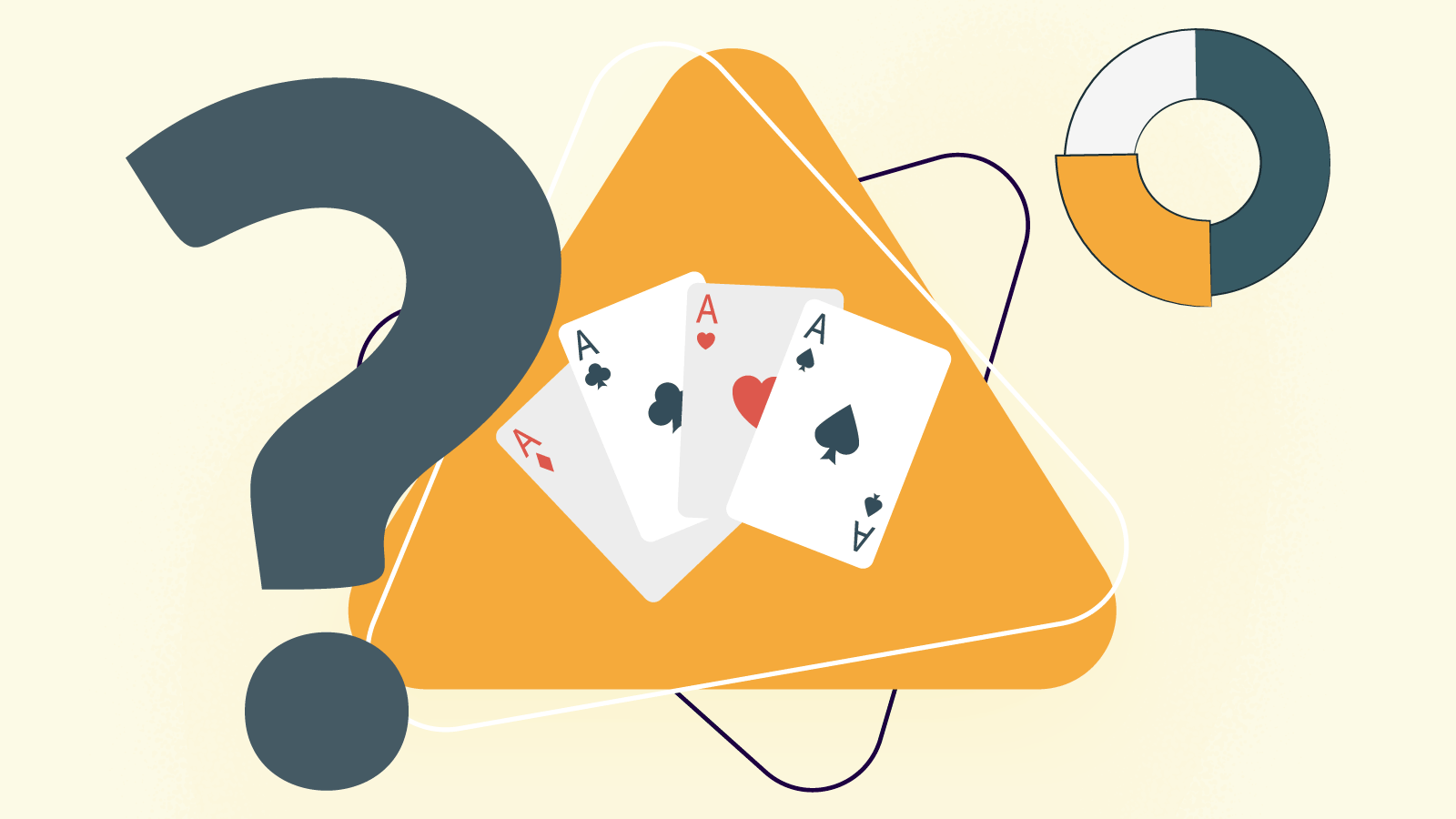
It is the standard rule for classic tables. However, it will not be the only one you will find in gambling environments.
Casinos have started showing a greater variation in the table game options and rule versions. One place where available games will differ is the player Blackjack payout. Nowadays, most of the best online casinos in the UK will also feature tables where the ‘Blackjack Pays 3 to 2’ is replaced by 6:5, 2:1, or even 1:1 payouts, as is the case for Switch options.
The Importance of the Blackjack 3 to 2 Payout
There’s one clear reason for which the 3:2 rule has fallen out of the casino’s favour, especially with the advent of its 6:5 counterpart.
Be aware
The 6:5 Blackjack payout rule is disadvantageous to the player and raises the house advantage by about 1.3%.
Nonetheless, the 6 to 5 amount is still better than the 1 to 1 pay scheme that you find in Switch Blackjack games. Some tables can also have a 7 to 5 pay rule, which is also worse than the standard.
Tips
The best rule variant has a 2 to 1 return. This option is even better than the standard table game payment rule.
These facts may not come to light outright, but if you use the algorithm of discerning returns for a wager, you will see the difference:
Payout Chart Comparison
| Pay Scheme Variations | Fractional Equivalents | The Return for a £5 Bet | House Edge Effect |
|---|---|---|---|
| 3:2 | 1.5:1 | £7.5 | +0% |
| 6:5 | 1.2:1 | £6 | +1.360% |
| 7:5 | 1.4:1 | £7 | +0.453% |
| 1:1 | 1:1 | £5 | +2.266% |
| 2:1 | 2:1 | £10 | -2.266% |
Tips
There also is an additional rule that provides a 2 to 1 return for suited blackjacks. This option also has a wide effect on the overall table game house advantage.
The Blackjack 3:2 Payout Chart, Visualised
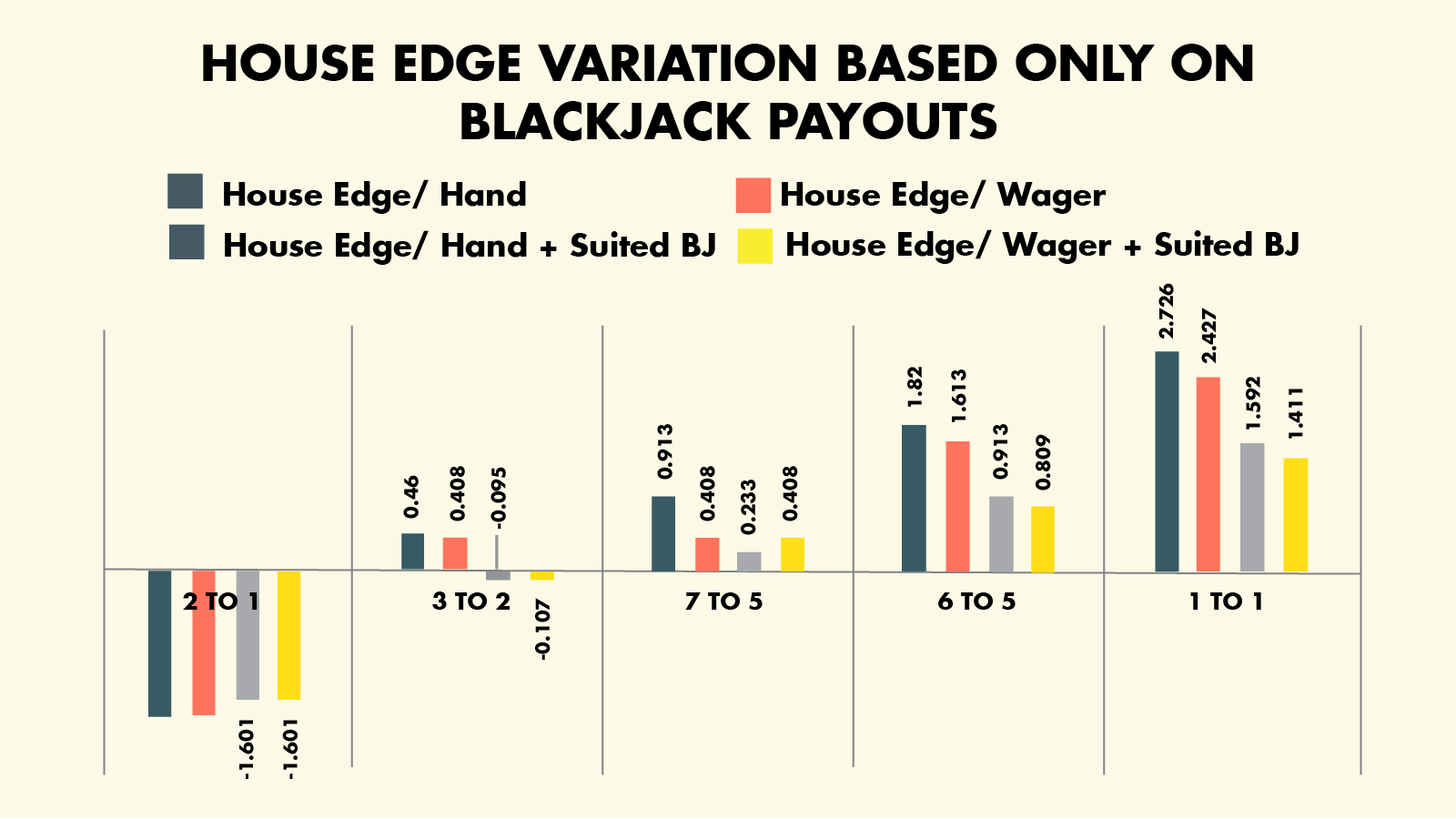
You may be surprised to see negative house edges in some instances. A negative house advantage indicates that you would effectively profit, and the bank will lose funds in time.
The reason is that we kept the same rules while the return on 21 was the only free variable. This approach should make it clear why the standard 21 pay scheme is so important.
Payout Chart Conclusions
- The 2 to 1 pay scheme is the best option out there. However, games with this rule will have other rule specifications to raise the house advantage and make the tables profitable for the gambling enterprise.
- The 3:2 table game versions are the standard ones present in most Blackjack rules. They also tend to be the most advantageous for British Blackjack players. If they also have a suited 21 rule, then the house edge will be balanced by some other rule variation.
- Do not participate in 6 to 5 game versions. The same goes for the Switch version that has the 1 to 1 payment. The house advantage additions, in this case, make them worse than the standard payment version.
- 7 to 5 versions are still worse and are only a good alternative for the 6 to 5 and 1 to 1 tables. They may be an option if they have extra betting variations that lower the house edge, for example, the suited 21 rule.
- While the standard card game 21 payment variant is the fairer among the options, rule variations will change the standard house advantage. Our British readers should know how each bet option changes the house edge.
Blackjack 3 to 2 Versions
We establish the standard game to have the following rules:
- It has eight card decks in play.
- Dealer stands on soft 17.
- You can double on any two cards and may double after split.
- You cannot resplit.
- Naturally, Blackjack pays 3 to 2.
- Dealer peeks for 21.
- No surrender.
- No number card bonuses.
- The cards get shuffled after each hand.
Under these rules, the standard house edge is 0.488% for hands and 0.433% for wagers.
Blackjack 3 to 2 Payout Chart with Rule Deviations
The house advantage for standard pay rule games increases by 0.213% per hand and 0.188% per your wagers. This change is one of the highest isolated effects per a single rule.
On the other end of the spectrum, in the specific case of blackjack 3 to 2 payout games, the ability to split a pair of aces reduces the bank advantage by a value between 0.166% and 0.187%. However, the biggest perk you can have at such a table is the 2 to 1 pay scheme for suited 21 hands. This added rule will reduce the overall house edge by a whopping 0.567% per hand and 0.337% for wager.
In the standard rule setup for the Blackjack 3 to 2 payout option, you would effectively make money in the long run.
These conditions will be crucial for choosing your correct table, but the following rule effects are still to be considered.
How Do the Card Decks Affect Blackjack 3 to 2 Payout Games
| Rule Deviations | Effect on house edge per wager | Effect on House Edge / Hand |
|---|---|---|
| Six Decks | -0.024% | -0.027% |
| Five Decks | -0.044% | -0.049% |
| Four Decks | -0.073% | -0.081% |
| Two Decks | -0.222% | -0.247% |
| One Deck | -0.532% | -0.594% |
As a rule of thumb, the fewer the card decks in play, the better your odds are for a win. Ideal options are double deck or single deck games, although these are rare in online casinos. It does not mean, however, that you will not find Blackjack casinos that feature such options, among many others.
Surrender Variation Effects
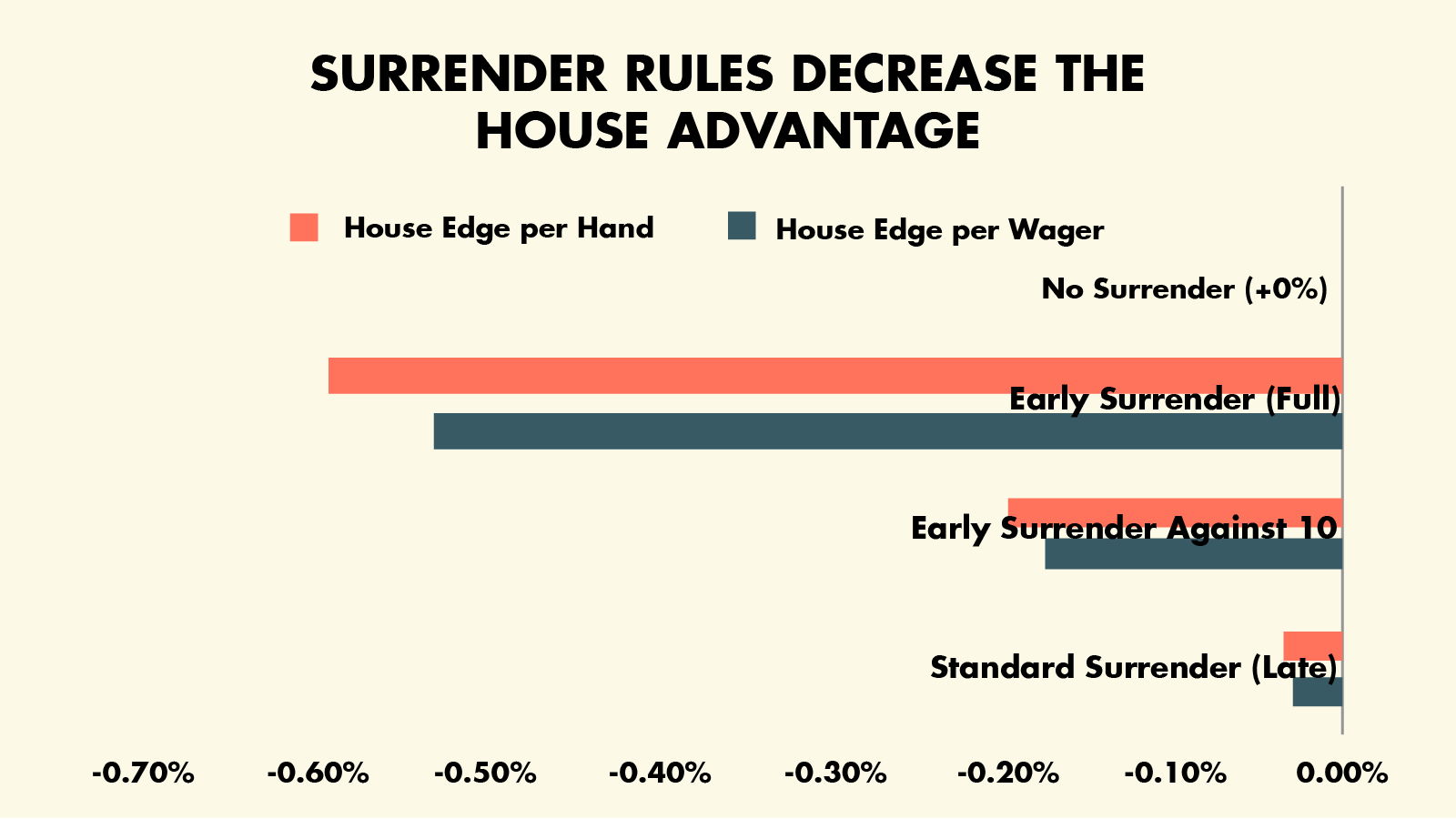
Double Down Effects on Blackjack 3 to 2 Payout Versions

Any limitation on what cards you may double down on will add to the house advantage and, in turn, decrease your chances to win. However, the effect of the double on 9 to 11 rule is almost non-existent when considering the house advantage per each hand.
Resplit Rules and Their Effects
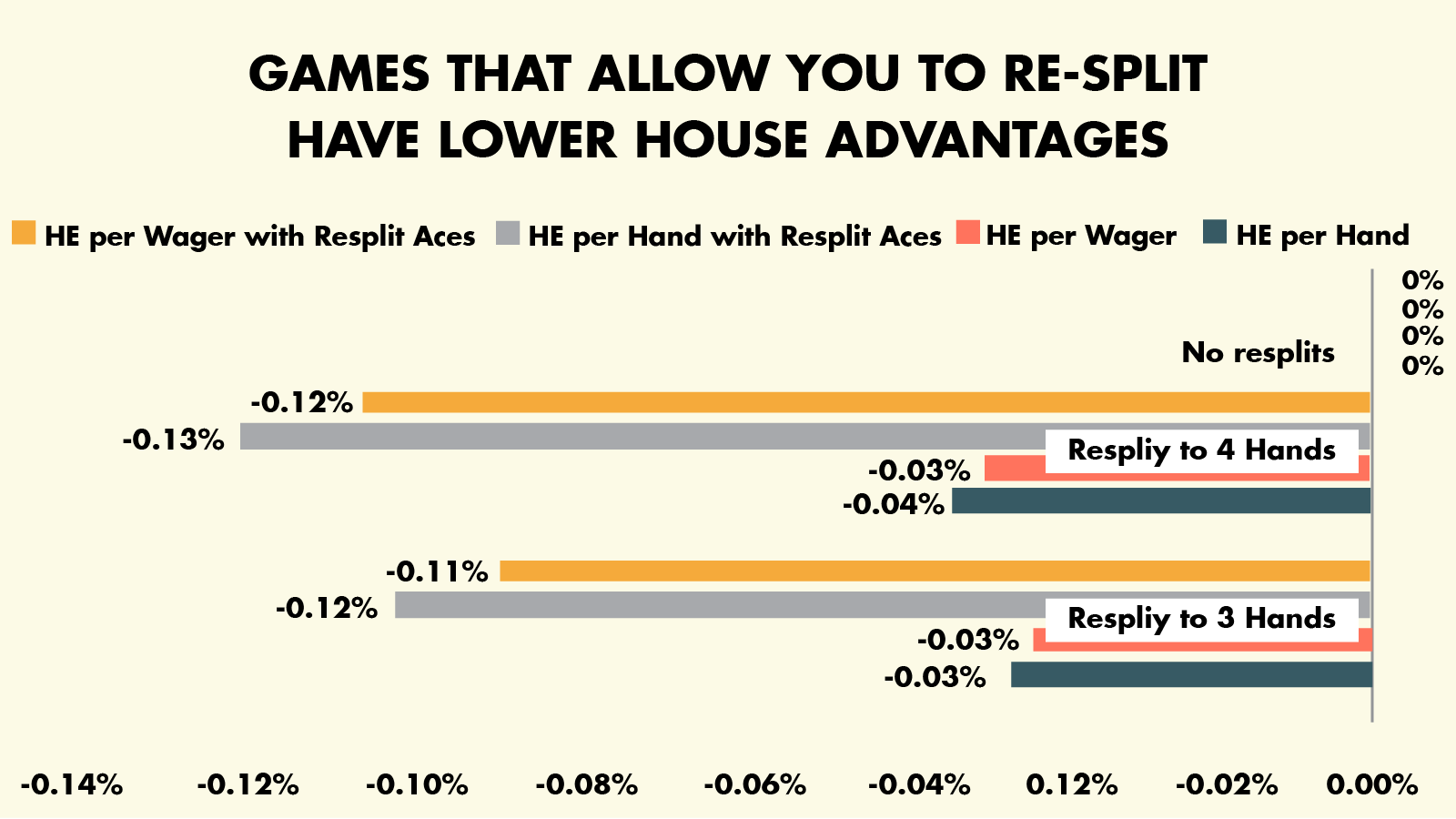
The more hands you are allowed to resplit to, the better your resulting pay chances. Naturally, being allowed to resplit aces gives you a considerable edge.
Dealer Peek Effects on Standard Game Versions
- Dealer Peeks for 21 – 0% for your hand and 0% for a wager.
- Dealer Doesn’t Peek for 21 – +0.123% per hand and +0.119% per wager.
- Dealer Peeks on Ace – +0.114% for a hand and +0.11% for a wager.
- Dealer Peeks on Ten-Value Card – +0.023% per hand and +0.02% per wager.
- Split bets are lost on peek – +0.041% for your hand and +0.037% for your wager.
Bonus Pay Effects, Rated
- 5-card Charlie: -1.444% per your hand and -1.292% per your wager.
- Six-card Charlie: -0.309% for a hand and -0.279% for wagers.
- Five or more-card 21 pays 2 to 1: -0.227% per hand and -0203% per wager.
- Five-card 21 pays 2 to 1: -0.185% per hand and -0.166% per wagers.
- Seven-card Charlie: -0.159% per hand and -0.033% per wager.
- 777 pays 3:1: -0.090% per hand and -0.081% per wagers.
We have to note that the 777 3 to 1 bonus can come with the several-card Charlie or multiple card 21 payouts. Thus, the best option for additional bonus payouts to the 3:2 rule would be the five-card Charlie plus the 777 3 to 1 payment rule.
The First Step to Understanding the Game

Now you have attained a solid grasp on the Blackjack pays 3 to 2 meaning of the rule and the difference between it and other pay versions. Additionally, we have provided scientific data regarding the effects of other rule variations on the standard 3:2 tables.
You have effectively begun your journey to understanding the table game and playing in an informed and safe manner. Our specialists on the subject will also provide you with the steps you need to follow up with now:
Follow-up Study Steps
- Get the hang of all other blackjack rules and table game basics.
- Study the table game odds of successful runs from fact-based sources.
- Get a thorough grip on the basic strategy. Beyond the choice of your table options, this will be the main method in which you reduce the objective house advantage.
- As part of this previous step, you will need to memorise the basic strategy charts for the rule variations you play with.
- Once you have some theory under your belt, scour the blackjack sites currently available for British customers. Pay attention to the rule variations available and the betting limits, plus online casino basics that our reviewers will make light of.
- Spend some time with the online games you chose and practice your skills. Make sure to stay in control of your gameplay and only stick to responsible and theoretically backed decisions.
- Find out about better methods of approaching the table game and reducing the house advantage. Delving deeper into your study will imply understanding basic game deviations. You may start taking notes and keeping track of discarded cards and finally finding better betting approaches. You may find out about card counting or investigate the feasibility and utility of approaches such as the Martingale blackjack system. The strategy does not necessarily inform your in-round play but can structure your betting across several rounds.
 Francisc Csiki
Francisc Csiki Tudor Turiceanu
Tudor Turiceanu